-Interior cross hatching
I started this post within another post concerning Wheel Variations", which received a response from Terry so decided to start a new thread dealing exclusively with the cross hatching under the roofs of many models. This what I wrote in "Wheel variations":
I had been writing to Jacques "dinkycollect" about his use of the word "chequered" in describing the interior of the last issue of the 255 Mersey Tunnel Police Van. "At first I did not understand when you wrote the interior having a chequered ceiling cab, until I realised that I had been used to the terminology cross-hatched, going back to the days of Classic Toys magazine and the article on the 29h/282 Duple Roadmaster Coach. Cross hatching as you know became a norm when difficulties were starting to be experienced in ejecting the model from the mould. It appears with my favourite, the 965, although not in a sequence that would be expected."
I have seen cross-hatching inside late issue 282 Duple Roadmaster Coaches and the 965 Euclid Rear Dump Truck. How many models ended up receiving this treatment to solve an ejection problem as well as to prolong the life of the mould? I have never given cross hatching much thought, so can members add to the two I have listed? (I now have to go through all my models and see what others should be included. Photographing them will be difficult I imagine!)
Bruce
Sorry, Bruce, hadn't seen this new thread yet and posted this one earlier in the Wheel variations thread:

This is the 'cross hatching', or whatever you call it, of the Mersey Tunnel Police Van's inside roof. It improves the flow of the zamac, especially near the tiny window pillars.

Although not very spectacular, there are even more differences to be found among the MTPV's issued. Of course tyres can be replaced, but the model can be proven to have been fitted with white or black smooth 15 cm tyres, the black ones treaded from 1957 on, and also the bigger smooth 17 mm tyres. Besides that there are three sizes of texts on the doors, transfers and stamps. Finally the shades and gloss of red can differ significantly.
Kind regards, Jan
Many thanks Jan! I have just posted my comments on Wheels Variation! Good to see we are now on the same wavelength!
Thanks too for the photo of the two interiors. Makes it easy after the model has been disassembled - a little harder on a example not in need of restoration! Kind regards, Bruce
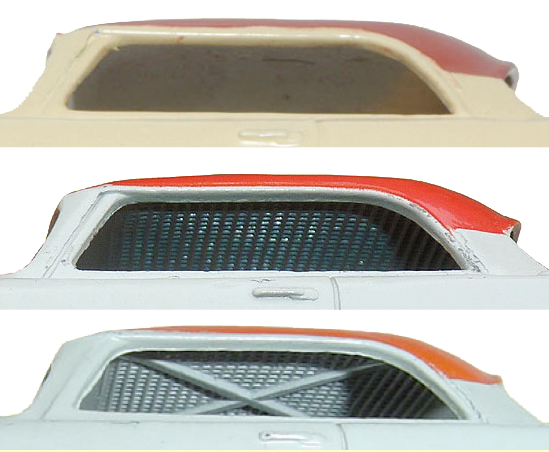
24D Plymouth Belvedere
This model has three ceiling variations (I have never seen a Dinky with cross-hatched roof).
Gentlemen
Since starting this Thread, I have been looking carefully at the Dinky Toys and Supertoys in my collection. Having five 642 Pressure Refueller's in my collection, each in their individual blue-striped box, I examine each, and all did not have any cross-hatching. Then in a dusty box, I discovered a long-lost example, but unfortunately, without its box. Looking at it, I was very surprised to see that this one had cross-hatching on the interior of the cab. Shining a flashlight into the rest of the casting, no other cross-hatching was visible. Obviously this model was a late issue as all the other boxes were dated April, May and June 1957.
Bruce

Bruce,
Good find.
The cross hatched models are always later issues than the smooth ceilings.
Have you noticed that Meccano failed to reproduce the headlights which should be below the bumper ?
Jacques.
Jacques
Yes indeed, as well as a number of other features, although I guess they were aiming for a simple, uncomplicated casting.


I wonder if other members can check their 642 Pressure Refuellers to see if we can find more with cabin roof interior cross-hatching still in their original box together with an inspection stamp on the inside of the box's lid. Certainly would aid in learning the approximate date when the cross-hatching took place.
Kind regards
Bruce
I have always been fascinated with the "checkering" or "cross hatching", and first noticed it around 1958 or so, when another Dinky collector and I first noticed that some of our French Dinky's had it, and some did not. Then we noticed that my older Citroen 11BL did not have it, but a newer one did. We often wondered why, as then there was no explanation available.
I have posed the question before, but don't remember much discussion about it, other than to know that it was done to facilitate the casting process. From my own observations, it appears that the French started doing it at least by 1956 or so, and maybe a little before...say 1955. But I don't remember any of the English made Dinky's having it until several years later. And that has always prompted another question I always have....how much the two factories shared information on casting issues, etc. If the French found it so beneficial, why did Binn's Rd. wait so long to implement it?
Another question......are there notations on the drawings extant that show this being added? I don't remember seeing a specific change shown regarding this.
Terry
Terry,
I have answered this question several times on various forums.
"checkering" or "cross hatching"is applied to large flat surfaces to facilitate the flow of metal in the die and reduce the weight of the toy but also to save on the metal. If you save 10 gr. on 1 000 000 models you have saved 1 ton of zamac.
The main reason is that large flat surfaces such as car roofs, tippers etc
As can be seen, the above Post lost much of its content before or during the transfer process from the old website to the new. The following is that Post in its entirety, again with thanks to AK:
dinkycollect wrote: Terry, I have answered this question several times on various forums. "Checkering" or "cross hatching" is applied to large flat surfaces to facilitate the flow of metal in the die and reduce the weight of the toy but also to save on the metal. If you save 10 gr. on 1 000 000 models you have saved 1 ton of Zamac.
The main reason is that large flat surfaces such as car roofs, tippers etc… are kept thin and the metal does not fill the die completely or makes a turbulence leaving a nasty pattern or depression on the casting which has to be rejected and re-cast. The dies are highly polished when new, this eases the flow of metal but with aging, the surfaces are not so smooth and this slows the flow of metal. This is the reason why the cross hatching is usually not found on early models.
Some models such as the 24D Plymouth Belvedere, 25C Citroën H type van or 32E Berliet fire engine have also had flow channels added to the ceilings. I agree that this technique started in 1956 or maybe 1955 with the 24N Traction. It would be interesting to make a list of the models with cross hatching to know when this stopped. Did any of the models with windows have it?
My experience with R&D in multi nationals is called the NIH for "Not Invented Here". If anything is invented in a R&D dept else than the one of the mother company, it is considered not any good. Was it the same between Bobigny/Calais and Liverpool? About the technical exchanges between the factories, there may have been the language barrier. How many people could speak English in Bobigny and how many could speak any French in Liverpool? Richard may be able to tell us a bit more on this subject.
Jacques
The 965 does have cross-hatching inside the cabin, but it does not seem to be in an expected sequence. Cross hatching is in a Euclid packaged in a half pictorial yellow lift-off lid box, and yet when the model was changed to Terex, one would expect these would also have cross-hatching, but this is not the case. My Terex with the Euclid base DOES NOT have cross-hatching inside the cab when in fact it should have. The Euclid that followed the lift-off lidded box packaged in the pictorial end-flap box has cross-hatching. The last Terex issued in an end-flap box, white sided with a drawing of the model, has no cross hatching. This model was bought in June 1970 from Hobbyco in Sydney. I know the preceding may not make sense but I will later try to post photographs of each example in a possible chronological sequence. But it is interesting to see that the first Terex did not have cross hatching and yet the last Euclid's did.
Kind regards
Bruce
20130404/867/0047
THIS POST IS A REPETITION OF POST #10 - Somehow it has been duplicated before or during the transfer from the old to the new website.
Bruce (150)
Bruce,
This means that the cab of the Terex was cast in a new die.
To change the name on the grille, it was necessary to replace the part of the cab die which corresponds to the grille, bumper and headlights. As the whole die may have been a bit worn, it was choosen to replace the whole die. This is confirmed by the fact that the name TEREX is not raised and the lack of cross hatching. This is not mentioned on the drawing job No. 13 972 which only states : "Title was Euclid truck, Terex was Euclid on radiator 3.1.69".
The cross hatching is not mentioned in the list of changes.
Jacques
I wrote my post in the wee hours of this morning, and what you stated was what I had intended to include! It is becoming quite apparent that the Terex Cab was a new casting, so perhaps it may have had a new drawing, although I cannot see why this was not reflected in the Terex drawing 13970. Perhaps it might be helpful if members could check their Terex models and confirm if their's also has no internal cross hatching on the cabin roof. It is possible the new casting is reflected in "Title was Euclid truck, Terex was Euclid on radiator 3.1.69", with January being the month in which the new casting was created, although it seems a lot of expense for a model that only had a year or so of being in production although at the time, the life expectancy of the Terex was an unknown factor. One thing I have noticed, are the castings for every Euclid right up to those packaged in the end flap box are clean, clear and with no apparent defects of a minor nature that would warrant a new die being made. Perhaps something drastic happened to the original die - who knows!! Maybe out there is a Terex with internal cab cross hatching!! Let us all check our Terex models!!
Bruce
I checked my Terex 965 and found no cross hatching
boumpa
Many thanks "boumpa" for taking the time to check your Terex and to find that it did not have cross-hatching on the interior ceiling of the cabin. Your information is most appreciated. I hope others will do so as well, in addition to checking their 642 Pressure Refuellers.
Kind regards
Bruce
Dinkinius
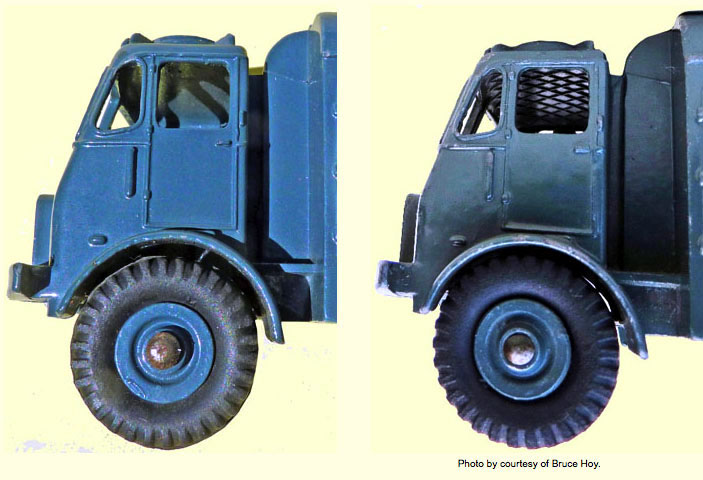
The interior ceiling of the cabin of my Pressure refuellers is smooth !
Richard
Hi all,
Both my early (no windows, grey decal) and my late (windows, red decal) Euclids are smooth,as expected, the RAF fueller is too, no X hatching here!
Chris Warr.
As my Terex 965, my pressuree refueler 642 does not have cross hatching
kind regards
boumpa
Merci Ronald.
dinkycollect wrote:
 "
"
Jacques - what a splendid job you have done with this photographic comparison! To Chris and Richard, many thanks for your input. It is starting to appear that the 642 Pressure Refueller with cross-hatching on the ceiling of the cabin is not very common - at least until more can check their models. It also may have revealed the possible reason why this model had a relatively short production life - a problem may have arisen with the die/mould and the cross-hatching, a temporary solution did not really solve the problem. Of course this is purely conjecture, but considering that Meccano would have needed to recoup its development costs, a long production life for each model has always been the rule rather than the exception. The 642 has always been one of my favourite models and it is nice to start learning a little more about it.
Bruce
If I can be of help, here is my contribution. I have no 'circumstantial evidence', like a box or other related information of the exact dating of this very example.
Kind regards, Jan
Bruce, by pointing at that repetition of the post my attention was newly drawn by Jacques' remark:
"Checkering" or "cross hatching" is applied to large flat surfaces to facilitate the flow of metal in the die and reduce the weight of the toy but also to save on the metal.
I wonder if cross-hatching applied to a surface that was initially smooth reduces the amount of metal to be used. If the hatching lines are to be 'engraved' into the smooth surface of the die (in a mirrorred way) they need more metal to be filled. Or, on the other hand, is it really feasible to heighten the die at the spots of all the tiny squares in between? And if the cavity in between really gets thinner, uses less metal, does not that thinner cavity eliminate the advantage of the newly applied hatched 'flow channels'? Did anybody measure possible reduction or increase of a roof's thickness and/or a difference in weight? (I'm sorry that Jacques himself will most probably not be able to comment at this moment). Kind regards, Jan
Jan---That is an interesting comment, and the first time I remember hearing that it was also to save material and thus less weight. In the past, when I first asked about why the cross-hatching, it was always to help the molten metal flow.
Bu the way, as a young boy and avid collector, I had several French made Dinky's, and noticed very early on that some had the checkering and some did not........even the same model, such as an early and then later Citroen 11 BL. I wondered about this for many years and had no idea what the purpose was. But if the goal was to reduce material usage, wouldn't they tend to use this everywhere? Why on the roof ceiling only, or has it appeared elsewhere?
Best regard, Terry
A few simple questions.
1. Do we know how many moulds were made for each model at the same time, was it just one or numerious?
2. How many castings were expected out of each mould?
3. Each time a mould was replaced the newly made would likely try to eliminate any problems incurred previously or include any potential cost savings. The question then if numious moulds for each casting, it is possible as moulds would not necessaryly be replaced at the same time that different finishes for each model could be being cast at the same time.
Alterations to existing moulds ie engraving would always result in additional metal, see the road roller "Moto-cart" changed to "Motocart", the digging out the mould to form the cartouche correcting an earlier mistake.
David
Dear Terry and David
In a post above, I probably did not explain enough when I wrote that cross-hatching was to reduce the quantity of metal. This is because the alternative to cross-hatching was to make that area thicker.
Three is no information about how many moulds were made for each model but ther was usually one only. There is evidence that parts of a mould had been replaced (24u Simca Aronde) and that two moulds were made one after the other (521 Bedford artic) a third case is that two complete moulds were made at the same time ( Bedfords TK or 33 Simca Cargo) because the planed production figures were high. Such moulds vere never identical and several variations can be found between them. Raised lines like those on the roof of the 28e Isobloc coach, the roof of the 811 caravan or the tipper of the 585 Berliet GAK end tipper are other means of mastering the metal flow in the moulds. Cross-hatching is not done only on the ceiling of cars but also under the bonnet or boot.
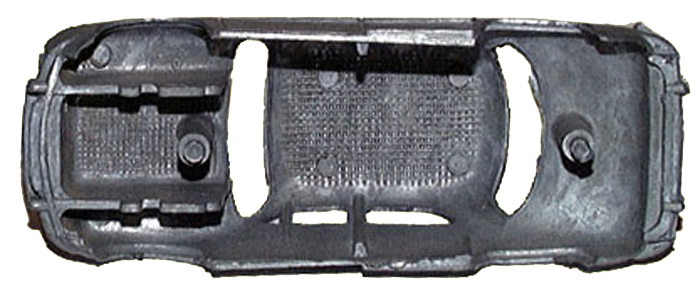
24 E - Renault Dauphine
There is almost no information on how many models were cast in each mould but the figure is certainly above 1/2 a milion. Only a few models may have reach such a production figure so only one mould was made.
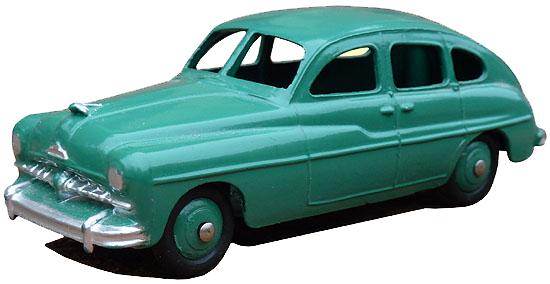
24 Q - Ford Vedette 1951
As stated on page 24 of the April 1954 issue of the French Meccano Magazine 500 000 models had been made when this model was withdrawn
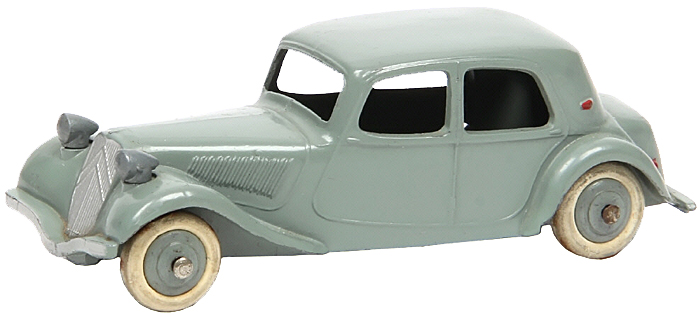
24 N - Citroën 11 BL said big fifteen
The" Meccano Actualités" news letter informs us that the Citroën 11cv is the first Dinky Toys (French or French + English ?) to have been made at more then 1 000 000 units. We do not know if this means the car with a boot or both models.
Moulds were never engraved. They were first machine tooled (raised door lines) and in Liverpool from 1960 made by spark erosion (recessed door lines). Yes, any alteration of a moulds results in more metal been needed for each casting. It is extremeny difficult to do the oposite : any change made by adding metal to the mould.
Jacques
Can see I used the wrong word 'engraving', for any alteration of any mould.
Just been reconciling the maths to put the quantiy into some sort of perspective for me to comprehend.
Assuming 24 /7 production, which am sure was not the case,1,000,000 models, using one mould would be
19230 models for a 7 day week,
2747 models per 24hour day,
114 models per hour,
or just under 2 models per miniute for each mould.
Obviously some models were in production much longer than one year and also there was probably a six day per week or even a five day. It is also unlikely that there was production for each 24 hour.
It just puts the numbers into perspective the amount of work each mould would need to do.
Question, would a mould need to rest between each pour because of the heat or can a mould work continiously for long periods. Would imagine it is the same today as it was then.
David
Is it the general understanding then that each variation of a casting replaced the a worn out predessor or was it just an addition to the cast ability, hence cross overs in time ie two slightly modified castings in production at the same time.
David
More figures from the September 1954 issue of the French Meccano Magazine, I doubt that any more exist.
24 N - Big fifteen 550 000 after 4 years of production but there were 3 more years to go. The total production figure is over 1 000 000.
24 R - Peugeot 203 450 000 after 4 years of production but there were 5 more years to go
24 T - 2 cv 490 000 after 4 years of production but there were 9 more years to go
24 U - Aronde 260 000 after 1 1/4 years of production but there was 1 more year to go
Do not calculate the total production for each of these models, it can not work because a huge initial run was made before the date of issue so that every shop in the world gets at least one trade box of 6. From this the production figures were reduced until the minimum economic figure was reached, it is then not economical to launch a new run and the model is deleted from the catalogue.
David,
I am not sure that I understand your question in # 28.
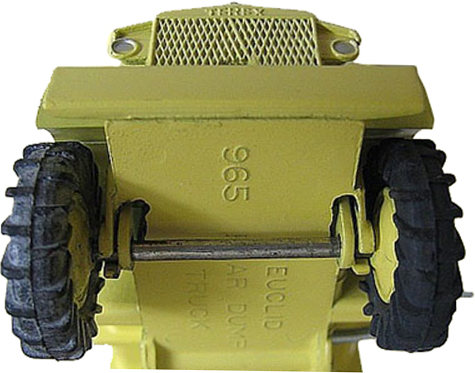
photo by courtesy of Bruce Hoy
If a mould is modified, there is no going back but of course there are unassembled parts in the store which will be mixed at random with the new modified parts making hybrid models like this Euclid / Terex truck which has a Terex grille and a Euclid chassis.
If I did not answer your question, let me know.
Jacques
David,
Moulds can run permanently 24 hours a day, they do in some factories but not at Meccano. They are heated electrically and by the injection of molten metal which itself is re-heated by compression through the small injection nozel.
There are two official production figures for the Bobigny factory which was much smaller than Liverpool.
• 1951 - 7 000 000 Dinky were made that year
using 600 ton of zamac and 26 000 000 tyres
• 1956 - 12 000 Dinky were made every day
The Meccano Magazine of September 1954 contains an article about the manufacturing of Dinky Toys which states that the output of the factory was of 24 Dinky every minute. Of course this meant different models been made at the same time. No mould could run at such a rate. The article also says that the rate of a mould was 5 - 7 castings a minute meaning a model every ten seconds.
Jacques
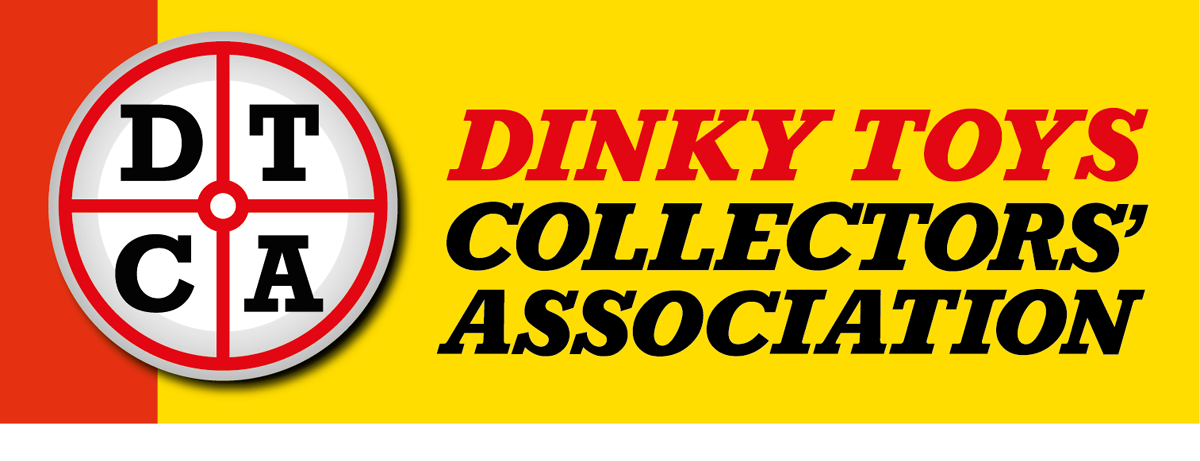

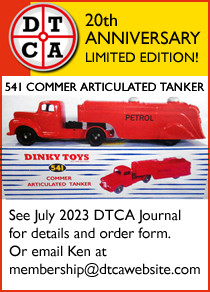
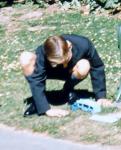
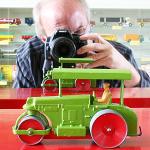
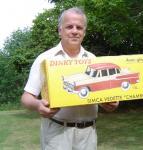
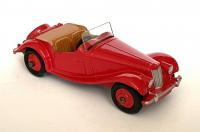
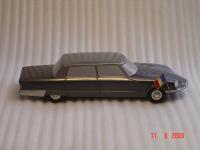
-914 AEC Articulated Lorry (1965-70)
-163 Bristol 450 Sports Coupé (1956-60)
-163 Bristol 450 Sports Coupé (1956-60)
-914 AEC Articulated Lorry (1965-70)
DTCAwebsite upgrade 2023
DTCAwebsite upgrade 2023
DTCAwebsite upgrade 2023
DTCAwebsite upgrade 2023
DTCAwebsite upgrade 2023
DTCAwebsite upgrade 2023
-508 DAF
--14c and 401Coventry Climax Fork Lift Truck (1949-64)
FRENCH DINKY TALBOT LAGO
-Boxes General Discussions including end flaps, both British and French
--14c and 401Coventry Climax Fork Lift Truck (1949-64)
--14c and 401Coventry Climax Fork Lift Truck (1949-64)
-508 DAF
DTCAwebsite upgrade 2023
DTCAwebsite upgrade 2023
DTCAwebsite upgrade 2023
DTCAwebsite upgrade 2023
DTCAwebsite upgrade 2023
-508 DAF
-508 DAF
-508 DAF
New arrivals
New arrivals
DTCAwebsite upgrade 2023
DTCAwebsite upgrade 2023
ORIGINAL MECCANO DINKY TOYS FACTORY BOX ART 175 HILLMAN MINX SALOON + DRAWING
--29c and 290 Double Decker Bus (1938-63)
DTCAwebsite upgrade 2023
DTCAwebsite upgrade 2023
DTCAwebsite upgrade 2023
DTCAwebsite upgrade 2023